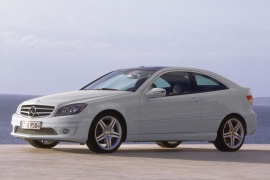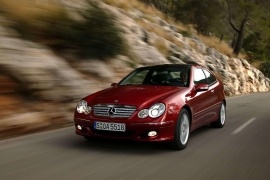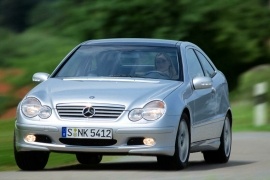MERCEDES BENZ C-Klasse SportCoupe/CLC Models/Series Timeline, Specifications & Photos
First production year: 2000
Engines: Gasoline, Diesel
Body style: Coupé (two-door)
Mercedes-Benz unveiled the CLC as a successor for the C-Class Sportcoupe at the Berlin Fashion Week in 2008, but it was a bridge between the C-Class W203 and W204.
By 2008, Mercedes-Benz still didn't have a proper competitor for BMW 3-Series Coupe, and the two-door hatchback version of the C-Class was more of a competitor for the 3-Series Compact. But it was its best bet until a proper C-Class Coupe was available. The CLC was based on the same platform as its predecessor and shared the main shell, roof, and door panels with the C-Class Sportcoupe.
The 2008 CLC featured similar-shaped headlights, with the 2007 C-Class (W204) and body-colored door mirrors and handles. In the back, Mercedes-Benz installed new taillights with a similar shape as those from the C-Class sedan. On the new tailgate, the carmaker added an LED light strip for the brake lights.
Inside, it carried over most of the parts from the 2005 C-Class Sportcoupe. Its dashboard featured two larger dials for the speedometer and tachometer, flanked on the left by the coolant-temperature gauge and the fuel level on the right. In the middle, the carmaker placed an LCD for the onboard computer. The seats were new and provided a higher bolstering.
Under the hood, Mercedes-Benz installed a wide choice of engines with gasoline or turbo-diesel. The 1.6-liter and the 1.8-liter supercharged engines were paired with either a six-speed manual or with the old five-speed automatic gearbox, while the more powerful versions were mated with the seven-speed automatic transmission. The carmaker used only the 2.2-liter CDI unit for the diesel versions in two power outputs: 122 hp and 150 hp.
MERCEDES BENZ CLC (W203) 160 BlueEFFICIENCY 5AT RWD (129 HP)
MERCEDES BENZ CLC (W203) 160 BlueEFFICIENCY 6MT RWD (129 HP)
MERCEDES BENZ CLC (W203) 180 Kompressor 5AT RWD (143 HP)
MERCEDES BENZ CLC (W203) 180 Kompressor 6MT RWD (143 HP)
MERCEDES BENZ CLC (W203) 200 Kompressor 6MT RWD (204 HP)
MERCEDES BENZ CLC (W203) 230 6MT RWD (204 HP)
MERCEDES BENZ CLC (W203) 230 7AT RWD (204 HP)
The mid-life cycle of the C-Class W203 affected also the Sport Coupe version. It was launched in 2004 and it came with improvements in more areas.
The second generation of the C-Class was launched in 2000 and in 2004 it was already the time for a mid-life cycle refresh. The 2004 model brought modifications on all parts: exterior, interior and engines. It also solved the problems with the paint quality, which suffered in the first models.
On the outside, the main difference was noticed at the headlights. The 2004 model featured new headlights with clear lenses for the standard version. The front bumper featured an enlarged lower air intake with a new louver structure in place of the previous mesh grille. The front track was wider by 40 mm (1.6”) than the 2002 model. The models equipped with EVOLUTION or EVOLUTION AMG sports packages came with a special paint finish in brilliant silver and perforations on the radiator grille slats.
The instrument cluster featured a new layout with four round dials and a vertically mounted information LCD between the speedometer and tachometer. The steering wheel featured different buttons design for the onboard computer and the audio system. On the center console, there was a new infotainment unit available and new controls for the climate control unit.
Under the hood, the 2.2-liter diesel engines were upgraded to Euro4 emission norms and new, direct-injected gasoline units were installed. The newly developed 7G-Tronic was available for the 230 Kompressor version, while the older 5G-Tronic was kept for the others.
MERCEDES BENZ C-Klasse Sport Coupe (W203) 160 Kompressor 5AT RWD (122 HP)
MERCEDES BENZ C-Klasse Sport Coupe (W203) 160 Kompressor 6MT RWD (122 HP)
MERCEDES BENZ C-Klasse Sport Coupe (W203) 180 Kompressor 5AT RWD (143 HP)
MERCEDES BENZ C-Klasse Sport Coupe (W203) 180 Kompressor 6MT RWD (143 HP)
MERCEDES BENZ C-Klasse Sport Coupe (W203) 200 Kompressor 5AT RWD (163 HP)
MERCEDES BENZ C-Klasse Sport Coupe (W203) 200 Kompressor 6MT RWD (163 HP)
MERCEDES BENZ C-Klasse Sport Coupe (W203) 230 6MT RWD (204 HP)
MERCEDES BENZ C-Klasse Sport Coupe (W203) 230 7AT RWD (204 HP)
MERCEDES BENZ C-Klasse Sport Coupe (W203) 230 Kompressor 5AT RWD (192 HP)
MERCEDES BENZ C-Klasse Sport Coupe (W203) 230 Kompressor 6MT RWD (192 HP)
MERCEDES BENZ C-Klasse Sport Coupe (W203) 320 5AT RWD (218 HP)
MERCEDES BENZ C-Klasse Sport Coupe (W203) 320 6MT RWD (218 HP)
MERCEDES BENZ C-Klasse Sport Coupe (W203) 350 6MT RWD (272 HP)
MERCEDES BENZ C-Klasse Sport Coupe (W203) 350 7AT RWD (272 HP)
Mercedes-Benz tried its luck on the compact segment with a shortened version of the C-Class in 2000 when it introduced the C-Class Sport Coupe.
Produced in Brazil to lower manufacturing costs, the C-Class Sport Coupe (CL203) was offered exclusively as a three-door hatchback. Its main competitor was the BMW 3 Series Compact, but the three-pointed star brand managed to create a sportier, better-looking vehicle.
Unlike the Bimmer, the C-Class Sport Coupe didn't share any part of its bodywork with its sedan sibling. At first sight, the twin-round headlights were the same, but they were actually completely different. Its sleek look, with a tilted grille and lower stance, surprised the market. From its profile, the sporty-looking coupe boasted an ascending beltline that ended at the back. At the rear, apart from the main windscreen, the tailgate featured a second glass area in the lower part.
Inside, the low-mounted seats created a sporty driving position but limited the legroom for the rear passengers. There was actually just enough room for small children. Even the automaker admitted that when it offered the Isofix child seat mounting system as an option. The dashboard looked similar to the one from the regular C-Class (C203), with a big speedometer that resembled a half-moon. There was no temperature gauge, but that could've been displayed on the small LCD placed inside the speedometer's arch.
Under the hood, the German automaker installed a wide range of gasoline and turbo-diesel engines, ranging from a sluggish 2.0-liter, naturally-aspirated unit up to a healthy 3.2-liter V6. Most versions were available with a five-speed automatic gearbox (5G-Tronic).
MERCEDES BENZ C-Klasse Sport Coupe (C203) 180 5AT RWD (129 HP)
MERCEDES BENZ C-Klasse Sport Coupe (C203) 180 6MT RWD (129 HP)
MERCEDES BENZ C-Klasse Sport Coupe (C203) 180 Kompressor 5AT RWD (143 HP)
MERCEDES BENZ C-Klasse Sport Coupe (C203) 180 Kompressor 6MT RWD (143 HP)
MERCEDES BENZ C-Klasse Sport Coupe (C203) 200 CGI 6MT RWD (170 HP)
MERCEDES BENZ C-Klasse Sport Coupe (C203) 200 Kompressor 5AT RWD (163 HP)
MERCEDES BENZ C-Klasse Sport Coupe (C203) 200 Kompressor 6MT RWD (163 HP)
MERCEDES BENZ C-Klasse Sport Coupe (C203) 230 Kompressor 5AT RWD (197 HP)
MERCEDES BENZ C-Klasse Sport Coupe (C203) 230 Kompressor 6MT RWD (197 HP)
MERCEDES BENZ C-Klasse Sport Coupe (C203) 320 5AT RWD (218 HP)
MERCEDES BENZ C-Klasse Sport Coupe (C203) 320 6MT RWD (218 HP)


